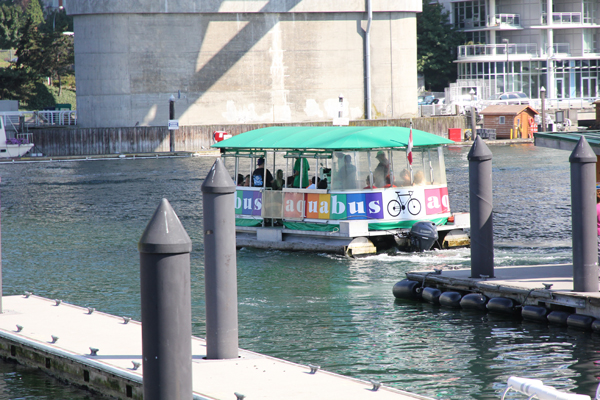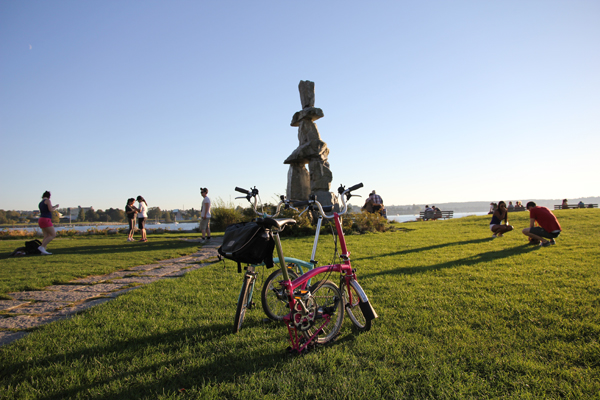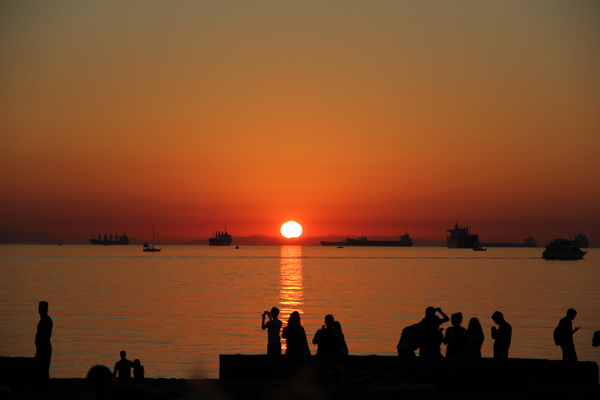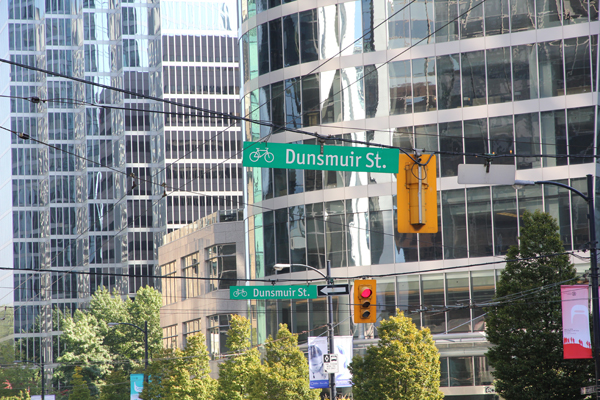Category: Vancouver, B.C. – Canada
Bike Vancouver – Part 2 of 2

Bike signage chiseled into concrete along the route of Vancouver Convention Centre. It’s on there for good.
If you are ever heading to Vancouver to bike, you should never skip the Seaside Bicycle Route. It is the best way to see the beauties of Vancouver and it will take you to many tourist attractions such as the new Vancouver Convention Centre, Stanley Park, English Bay and Granville Island. The route also takes you through local towns such as Coal Harbor, West End, Yaletown and Kitsilano. It is 15 miles or 24 km long, separated far away from noisy cars and next to the shore the entire way through.
However, on some sections of the Seaside Bicycle Route bicyclists have to share it with pedestrians (better than sharing it with motorists though). Because there are so many interesting and breathtaking sites to see, it may take the whole day, so you may want to separate the trip into a couple of days which we did.
If anything, you must not skip riding on the seawall of Stanley Park (see video above). It’s spectacularly wonderful! There are a lot of bike rentals in the area if you need to rent a bike.
You could cross over False Creek to cut your trip shorter by hopping on the Aquabus or False Creek Ferries at designated terminals. The fares are pretty reasonable and they make frequent pickups. The Aquabus accepts bicycles but not False Creek Ferries.
After a nice ride, you have to go this place that serves delicious Belgian waffles. It is called Nero Belgian Waffle Bar, located in the West End neighborhood.
Bike Vancouver – Part 1 of 2
We recently went to Vancouver, B. C. for a short vacation. It was my third and Nellie’s fourth time visiting the west coast Canadian city. We enjoy visiting Vancouver because it is the closest destination (just 2.5 hrs by plane from San Francisco) where we can experience something different from American cities. The people are nice and helpful and the city is clean, well laid-out, and beautiful. In addition, the food is excellent. You can randomly walk into any eatery and come out feeling satisfied. Vancouver has been ranking near the top in livability for the last few years and I can see why.

There is this 30 km seaside bicycle route that outlines the city. Pedestrians on the outer side and bicyclists on the inner side.
The last time we were there in 2009, we saw very little bike infrastructure. But recently, John Pucher, a cycling guru paid a visit to Vancouver and said that this city should be talked about as the best bike-friendly city in North America. The city was selected to have the Velo-City Global conference, a premier marketplace for bicycling delegates, which was held last year. They have mayor Greg Robertson who is a bike commuter and a city council that is not afraid of implementing bike facilities. Moreover, a bike-share program is expected to roll out early next year in downtown Vancouver. In addition to striped bike lanes, they have a few real cycletracks that are as good as those in Copenhagen, but of course they are not nearly as ubiquitous. Bikes are allowed in all modes of transit from buses to Sky Trains to Seabus ferries. Not to mention, a popular bike/fashion magazine called Momentum which is geared for regular people riding bikes, is based in Vancouver. Every year, there is a very large and notable turnout there for the World Naked Bike Ride.
Because Vancouver doesn’t yet have bike routes going everywhere, it is nice to see bike signs showing where the bicycle routes are. Having bike routes clearly marked and indicated on street name signs like the one shown above allows our eyes to automatically know where to look for the bike signage. It also helps drivers know to expect bicyclists if they are taking that street. It is so much better than placing bike signs on the sidewalks which are hard to see, can be blocked by tree branches or other nearby sign poles.
Although I despise anything that is just merely a striped bike lane, I think Vancouver does them better than San Francisco. For example, notice the green paint near the driveway for cars (see image above). It alerts drivers that they are crossing a bike lane and to look out for bicyclists. I think this is a brilliant way of using green paint. In SF, this is done in the opposite way. An example would be the Embarcadero in SF (sorry no photo) where the bike lane is painted green but when it reaches driveways the green paint disappears. What this signals is that it tells bicyclists to be the responsible party. It doesn’t make any sense, right?
In the image above, the bike lane is painted green as it reaches the intersection to warn motorists merging right to execute a turn that they are crossing through a bike lane. However in SF, this is not being done at all.
As mentioned in my other post, crossbikes are such a brilliant idea utilized by many bike-friendly cities. When you are riding across a busy/large intersection, do you ever feel that you are endangered? What about when you are walking and there’s no crosswalk? I got to ride in these crossbikes in Vancouver, and I can tell you it’s one of the best bike facilities ever created. Again, SFMTA needs to implement these.
There are five bridges in Vancouver, and four of them you can bike on. A popular bicycle route to get from downtown to the Kitsilano neighborhood (known for having the best beach in the city) is through the Burrard Bridge (image above). It has a dedicated cycle track for bicyclists. However, these bridges have a long incline and are not suited for any 8 to 80 y.o. bicyclist. What they need is a separated bridge just for bikes and pedestrians.
Below is a video (Note: Sound is muted, so don’t think your computer speakers are broken) showing what it’s like to ride in a cycle track in downtown Vancouver. (Editor’s Note: As you might be able tell in the video, he was having a ball!) The cycle track on Hornby St. is raised with car parking to the left, and a buffer with plants to the right of the parked cars. It is a great piece of bike infrastructure!
Although Vancouver has some great pieces of bike infrastructure and an amazing sea wall (which will be discussed in Part 2 of this series) navigating around Vancouver on a bike was not really that easy. It is still a very car-centric city. There seemed to be way more cars than when we were there before. There are many streets that do not yet have bike infrastructure. Riding on the main streets can be hair-raising. Also, there are only one or two streets going east to west that have bike routes. Then there are streets like Robson, Denman, Granville, and Davie Streets that are meccas for shopping and eating but do not have any bike routes on them. It seemed intentional that bike routes were not placed on them perhaps because they don’t have much space. But I thought that was kind of ridiculous. It is all a matter of re-prioritizing use. Bicyclists also shop and eat too, and studies (1,2) have shown they spend more money and frequent businesses more than motorists. At the very least, there should be bike sharrows.
In Vancouver, helmets are mandatory and I believe this could dampen ridership which may lead to less safety for bicycling on the streets. It should be optional for adults and mandatory for children. Motorists in Vancouver are courteous and more patient, and with some streets that have really good bike infrastructure, I don’t see why helmets are mandatory. In addition, they have a wonderful seaside bicycle route away from car traffic and they are still required to wear helmets there. What they need is to get more bicyclists on the streets and a helmet law doesn’t help with that.
I gotta admit, Vancouver is a hilly city. Although the hills aren’t as steep as San Francisco’s, it’s going to be tough to attract the 8 to 80 y.o. crowd. In order to get more people to bike over those hills and bridges, I believe electric bikes is the answer. I think if somehow electric bikes are marketed right like having e-bike shares for the public to try, that could be a good way to help people who are on the fence realize it is right for them.
Overall, Vancouver has done a great job in improving their bike infrastructure in just a few years. The speed at which they have been able to implement bike improvements is impressive.
In the next post on Vancouver, I will discuss more about biking along the sea wall in Vancouver and what we saw while biking around. Stay tuned…


















